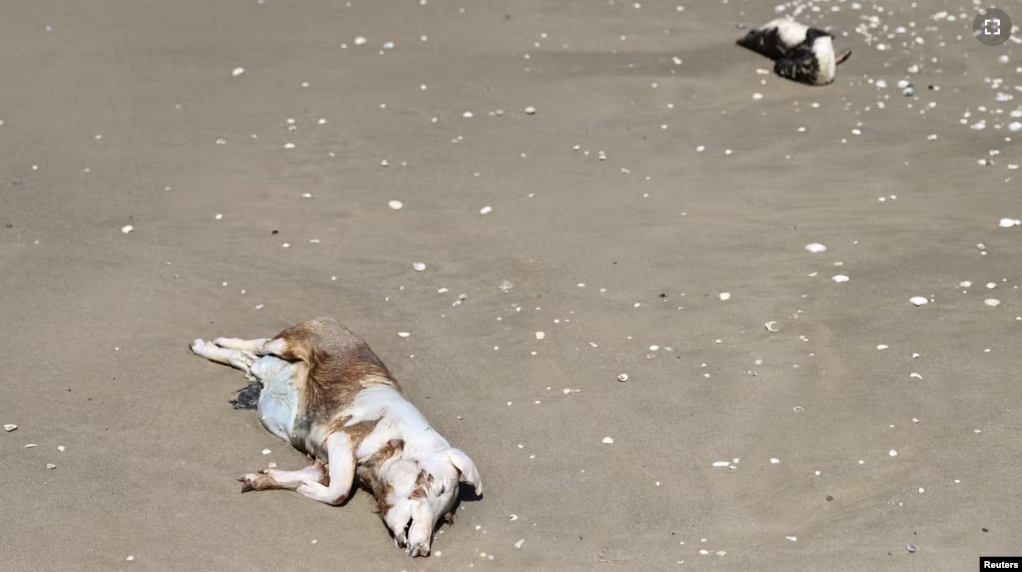The deadly H5N1 bird flu virus is spreading more aggressively than ever before since its arrival in South America in 2022. It is killing wild birds and marine mammals on the continent.
Reuters recently spoke to eight experts in bird flu science. All said the current spread raises the risk of the virus becoming a bigger threat to humans.
The more immediate concern is that the disease, which once affected mostly birdlife, appears to be spreading between mammals.
The disease has already killed several dolphins in Chile and Peru. It has also killed about 50,000 seals and sea lions along the coasts and at least half a million birds across South America.
Scientists have not yet tested infections in living animals to confirm mammal-to-mammal passage of the virus. But they believe it is very likely.
“It’s almost certainly happened,” said Richard Webby. He is a virologist at St. Jude’s Children’s Research Hospital in Memphis, Tennessee. “It’s pretty hard to explain some of these large infections and die off without having mammal-to-mammal spread.”
The same version of the virus has appeared in many bird species. Among them are migrating species, scientists told Reuters.
As climate change continues, animals are forced to move into new territories, often mixing with animals — and viruses — that are new to them.
“It’s a matter of time before you will detect the first South American strain in North America,” said Alonzo Alfaro-Nunez, a viral ecologist at the University of Copenhagen in Denmark.
Human risk
The growing concern led the intergovernmental Pan American Health Organization (PAHO) to gather health experts and officials for a meeting this week in Rio de Janeiro, Brazil.
The group plans to launch the world’s first regional program to supervise bird flu spread. The program will run observation and response efforts, a PAHO official told Reuters.
Since the virus was first detected in Colombia in October 2022, there have been two known cases in humans on the continent. One was in Ecuador. The other was in Chile. Birds passed the virus in each case.
The patients survived. But often, H5N1 kills. About 60 percent of human cases of the virus end in death.
The World Health Organization is unlikely to raise the H5N1 risk level for humans from the current “low” right now. The experts would require evidence of human-to-human transmission or signs of viral changes that would target humans, experts said.
Several drugmakers have said they are developing bird flu vaccines for humans.
“We’re seeing (the virus) do… little evolutionary steps that are on the long-term moving towards a potential human infection,” said Ralph Vanstreels. He is a researcher at the University of California, Davis. He is studying South American variants of H5N1.
Regional response
With health officials and experts meeting in Rio this week, Latin American countries will be pressured to increase disease surveillance in the wild.
The region’s data is lacking and limited resources have left scientists struggling to understand how the disease is spreading in the wild. Scientists expect the number of cases is probably much higher than reported. Some cases are not getting laboratory testing.
Bolivia, for example, did not register a case in the wild last year. But the disease has been reported in surrounding countries, said Manuel Jose Sanchez Vazquez, a disease expert for PAHO’s animal health center.
Overseeing the disease response can also be complex, Sanchez noted. Public health officials deal with threats to humans. Agricultural experts and veterinarians deal with health threats to farm animals, including birds, cows and pigs. But for wild animal health, care and supervision is provided mostly by environmental officials.
The new regional commission is expected to be announced on Thursday. The group would aim to set methods for observing, treating and reporting cases among government agencies. It could also help in sharing laboratory resources.
“We are worried and we are vigilant,” Sanchez said. “The more adaptation of the virus to mammals, the more likely it is that transmission to humans could happen.”
I’m Caty Weaver.
Caty Weaver adapted this story for VOA Learning English based on reporting by Reuters.
_______________________________________
Words in This Story
detect — v. to discover or determine the existence, presence, or fact of
region — n. an administrative area, division, or district
response — n. an act or instance of replying; answer
evolution — n. a process of change in a certain direction
potential — adj. existing in possibility : capable of development into actuality
vigilant — adj. alert to signs of danger
adaptation — n. modification of an organism or its parts that makes it more fit for existence under the conditions of its environment
veterinarian — n. a medical doctor of animals
